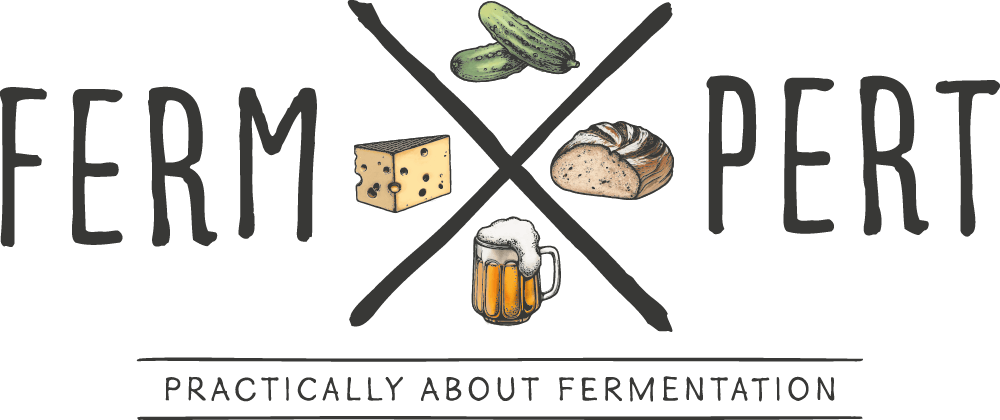Skyr hails from Iceland. It’s a white cheese that looks, tastes and has the same texture as Greek yoghurt. Making it at home is nearly as simple as regular yoghurt. The only ingredient that can’t be bought in every grocery store is rennet.
Recipe
- 1 L skim milk
- 1 tsp natural yoghurt with live bacteria cultures
- or freeze dried yoghurt bacteria cultures (Lactobacillus delbrueckii ssp. bulgaricus and Streptococcus salivarius ssp. thermophilus)
- rennet (half the dose per litre of milk recommended by the producer)
Pour the milk into a pot and heat to 85°C (185°F), constantly stirring so it doesn’t scald. Hold the temperature for 20 minutes in order to denature the whey proteins. Cool to around 43°C (109°F).
Stir in the yogurt or freeze dried bacteria. Dissolve the rennet in a small quantity of water and gently stir it in.
Hold the temperature of 43°C (109°F) for at least 8 hours. A yoghurt maker is perfect, but an oven with just the light bulb turned on will do just fine.
Transfer the skyr to a cheesecloth and strain out the whey. Put the skyr in a jar and refrigerate until consumed.
Additional Information
Skyr is different from Greek yoghurt in two aspects: the use of skim milk and rennet. The skim milk makes the finished product more diet friendly as it contains no fat. The rennet technically makes skyr a white cheese, despite its appearance and taste being nearly identical to yoghurt.
It’s possible to encounter recipes that don’t require the use of rennet. The end product however isn’t exactly skyr, but rather skim yoghurt.
Video Transcription
Traditional Icelandic skyr is technically a white cheese. However, it’s similar in taste and consistency to Greek yoghurt, and it is served in a similar fashion. Unlike yoghurt though, skyr contains no fat. An exact recipe can be found on the blog.
The main ingredient is skimmed milk. It would be ideal to use centrifuged raw milk, but I only have access to UHT milk, and it works too. The remaining ingredients are a bit of yoghurt and some rennet. It’s the rennet that causes skyr to be classified as a fresh cheese.
I pour the milk into a pot and heat it up. The sources I’m familiar with mention heating the milk to over 90°C (194°F) for ten minutes, which should denature whey proteins. I suspect this step is redundant in case of UHT milk.
I cool the milk down to 40°C (104°F). Then I stir in the prepared yoghurt. Adding it to hot milk would have killed all the bacteria in it.
Yoghurt is just a source of bacteria of the species Streptococcus salivarius ssp. thermophilus and Lactobacillus delbrueckii ssp. bulgaricus. They are the strains responsible for the typical taste of yoghurt. Freeze dried pure strains could be used too, but they’re harder to obtain.
The bacteria start to digest lactose immediately. Their most important metabolyte is lactic acid, which gives dairy products their distinctive tang.
The next step is adding rennet. I’m using half the dose recommended by the producer. I dissolve it in a bit of water, then pour it into the milk-yoghurt mixture and give it a stir.
Rennet contains an enzyme called chymosin. It affects casein micelles, the main protein in milk. It cuts off the part of casein that’s responsible for keeping milk in a liquid state. The outcome is that milk starts to form curds almost immediately after rennet is added.
I cover the pot and let it rest in a warm spot for several hours. I place it in the oven with just the light turned on. The light bulb tends to generate enough heat to create perfect conditions for bacterial growth.
After a few hours I remove the skyr from the oven. It’s perfectly curdled and there’s already visible whey separation. I need to remove the excess whey now. I use a sieve lined with a cheesecloth, which in my case is a cotton flat nappy. It turns out I used too small of a sieve, so I end up using two.
The whey will percolate through the cloth, leaving a deliciously thick skyr in the sieves. This process will take a few more hours.
When the skyr is done, it’s a good idea to keep the strained whey for later. It’s a refreshing drink and it can serve as a bacterial starter too. Meanwhile, I’ll prepare a quick dessert. I’ll whisk the skyr with a bit of vanilla extract and honey. I’ll serve it with a garnish of banana and blueberries.

